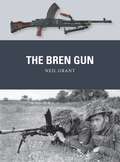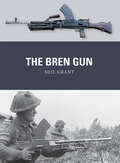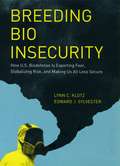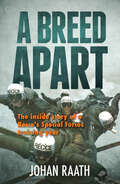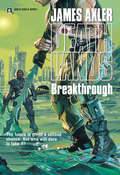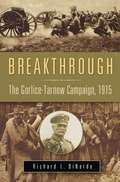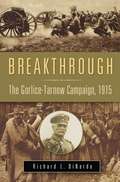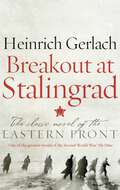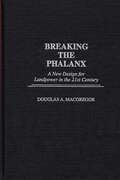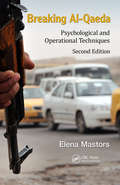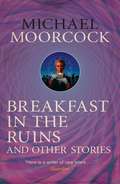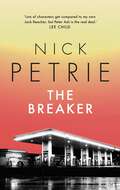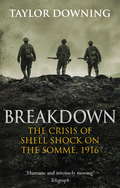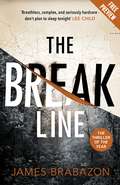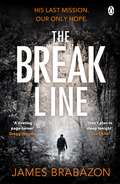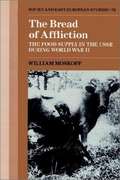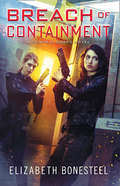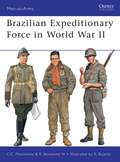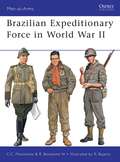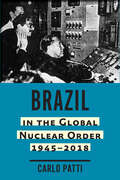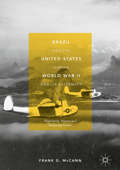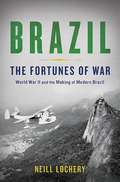- Table View
- List View
The Bren Gun (Weapon)
by Peter Dennis Neil GrantAdopted in 1938 and remaining in British service until 1991, the popular and reliable Bren was an iconic light machine gun, and arguably the most recognizable Commonwealth weapon of World War ll. Gas-operated and magazine-fed, it was based on a Czech design and was issued in large numbers during and after World War ll, as a section-level automatic weapon. Offering remarkable accuracy for an LMG, the Bren had an effective range of 600 yards, but could reach out to over 1,500 yards. It was generally fired from the prone position using a bipod, but could be fired from the hip when necessary. If kept clean, the Bren gave a reliable service in the harshest of environments, from the deserts of Libya to the Korean mountains in winter. As well as widespread infantry use, the Bren was widely supplied to resistance movements in Occupied Europe. Featuring specially commissioned full-colour artwork and based on meticulous research, this is an engaging story of the iconic light machine gun that equipped British and Commonwealth forces throughout World War II and in a host of postwar conflicts, right up to the Falklands and beyond.
The Bren Gun (Weapon #28)
by Peter Dennis Neil GrantAdopted in 1938 and remaining in British service until 1991, the popular and reliable Bren was an iconic light machine gun, and arguably the most recognizable Commonwealth weapon of World War ll. Gas-operated and magazine-fed, it was based on a Czech design and was issued in large numbers during and after World War ll, as a section-level automatic weapon. Offering remarkable accuracy for an LMG, the Bren had an effective range of 600 yards, but could reach out to over 1,500 yards. It was generally fired from the prone position using a bipod, but could be fired from the hip when necessary. If kept clean, the Bren gave a reliable service in the harshest of environments, from the deserts of Libya to the Korean mountains in winter. As well as widespread infantry use, the Bren was widely supplied to resistance movements in Occupied Europe. Featuring specially commissioned full-colour artwork and based on meticulous research, this is an engaging story of the iconic light machine gun that equipped British and Commonwealth forces throughout World War II and in a host of postwar conflicts, right up to the Falklands and beyond.
Breeding Bio Insecurity: How U.S. Biodefense Is Exporting Fear, Globalizing Risk, and Making Us All Less Secure
by Lynn C. Klotz Edward J. SylvesterIn the years since the 9/11 attacks—and the subsequent lethal anthrax letters—the United States has spent billions of dollars on measures to defend the population against the threat of biological weapons. But as Lynn C. Klotz and Edward J. Sylvester argue forcefully in Breeding Bio Insecurity, all that money and effort hasn’t made us any safer—in fact, it has made us more vulnerable. Breeding Bio Insecurity reveals the mistakes made to this point and lays out the necessary steps to set us on the path toward true biosecurity. The fundamental problem with the current approach, according to the authors, is the danger caused by the sheer size and secrecy of our biodefense effort. Thousands of scientists spread throughout hundreds of locations are now working with lethal bioweapons agents—but their inability to make their work public causes suspicion among our enemies and allies alike, even as the enormous number of laboratories greatly multiplies the inherent risk of deadly accidents or theft. Meanwhile, vital public health needs go unmet because of this new biodefense focus. True biosecurity, the authors argue, will require a multipronged effort based in an understanding of the complexity of the issue, guided by scientific ethics, and watched over by a vigilant citizenry attentive to the difference between fear mongering and true analysis of risk. An impassioned warning that never loses sight of political and scientific reality, Breeding Bio Insecurity is a crucial first step toward meeting the evolving threats of the twenty-first century.
Breeding Bio Insecurity: How U.S. Biodefense Is Exporting Fear, Globalizing Risk, and Making Us All Less Secure
by Lynn C. Klotz Edward J. SylvesterIn the years since the 9/11 attacks—and the subsequent lethal anthrax letters—the United States has spent billions of dollars on measures to defend the population against the threat of biological weapons. But as Lynn C. Klotz and Edward J. Sylvester argue forcefully in Breeding Bio Insecurity, all that money and effort hasn’t made us any safer—in fact, it has made us more vulnerable. Breeding Bio Insecurity reveals the mistakes made to this point and lays out the necessary steps to set us on the path toward true biosecurity. The fundamental problem with the current approach, according to the authors, is the danger caused by the sheer size and secrecy of our biodefense effort. Thousands of scientists spread throughout hundreds of locations are now working with lethal bioweapons agents—but their inability to make their work public causes suspicion among our enemies and allies alike, even as the enormous number of laboratories greatly multiplies the inherent risk of deadly accidents or theft. Meanwhile, vital public health needs go unmet because of this new biodefense focus. True biosecurity, the authors argue, will require a multipronged effort based in an understanding of the complexity of the issue, guided by scientific ethics, and watched over by a vigilant citizenry attentive to the difference between fear mongering and true analysis of risk. An impassioned warning that never loses sight of political and scientific reality, Breeding Bio Insecurity is a crucial first step toward meeting the evolving threats of the twenty-first century.
A Breed Apart: The inside story of a Recce’s Special Forces training year
by Johan RaathOver the years, many have signed up for the South African Special Forces selection course but only a select few have ever passed. The gruelling course pushes recruits to their physical and mental limits.Those who make it through selection still have to complete a demanding year-long training cycle before they can join the ranks of this elite unit. In A Breed Apart, former Special Forces operator Johan Raath offers a rare insider’s view on the training he and other young soldiers received in the mid-1980s. Drawing on the reminiscences of his fellow Recces, he describes the phases of selection and training, and offers valuable insights into what makes a successful operator.The courses in the training cycle show the range and standard of Special Forces training, including weapons handling, bushcraft/survival, parachuting, demolitions and urban warfare, as well as seaborne and riverine operations. For Raath and his cycle buddies, the training cycle culminated in an operation in southern Angola where the young Recces saw action for the first time.Much of what Raath underwent still forms part of present-day Special Forces training. Comprehensive and revealing, this book shows why these soldiers truly are a breed apart.
Breakthrough
by James AxlerMore than a century after a multi-warhead nuclear strike wiped out nearly all of earth's population, humanity's feral instinct to survive has spawned a savage new America. Here, the brutality of man and nature conspire against hope. Yet despite its chaos and bloody turmoil, Deathlands is a second chance for the human race…
Breakthrough: The Gorlice-Tarnow Campaign, 1915 (War, Technology, and History)
by Richard L. DiNardoAn expert on German military history offers the first extensive, English-language study of one of the critical campaigns of World War I.The Eastern Front in World War I has been neglected for too long. Breakthrough: The Gorlice-Tarnow Campaign, 1915 is the first English-language study of the first of the great breakthrough battles of the war—one of the Great War's critical campaigns.The book covers the initial attack of the German Eleventh Army and the Austro-Hungarian Third and Fourth Armies in Galicia as they outflanked the Russian position in the Carpathian Mountains that threatened Hungary. Subsequent chapters cover the retaking of Galicia, including the recapture of Przemysl and Lemberg. The examination concludes with the German and Austro-Hungarian forces under the command of August von Mackensen turning north from Lemberg and the subsequent overrunning of Russian Poland by the Central Powers.
Breakthrough: The Gorlice-Tarnow Campaign, 1915 (War, Technology, and History)
by Richard L. DiNardoAn expert on German military history offers the first extensive, English-language study of one of the critical campaigns of World War I.The Eastern Front in World War I has been neglected for too long. Breakthrough: The Gorlice-Tarnow Campaign, 1915 is the first English-language study of the first of the great breakthrough battles of the war—one of the Great War's critical campaigns.The book covers the initial attack of the German Eleventh Army and the Austro-Hungarian Third and Fourth Armies in Galicia as they outflanked the Russian position in the Carpathian Mountains that threatened Hungary. Subsequent chapters cover the retaking of Galicia, including the recapture of Przemysl and Lemberg. The examination concludes with the German and Austro-Hungarian forces under the command of August von Mackensen turning north from Lemberg and the subsequent overrunning of Russian Poland by the Central Powers.
Breakout at Stalingrad
by Heinrich Gerlach'One of the greatest novels of the Second World War' The Times. 'A remarkable find' Antony Beevor. 'A masterpiece' Mail on Sunday. Stalingrad, November 1942. Lieutenant Breuer dreams of returning home for Christmas. But he and his fellow German soldiers will spend winter in a frozen hell – as snow, ice and relentless Soviet assaults reduce the once-mighty Sixth Army to a diseased and starving rabble. Breakout at Stalingrad is a stark and terrifying portrait of the horrors of war, and a profoundly humane depiction of comradeship in adversity. The book itself has an extraordinary story behind it. Its author fought at Stalingrad and was imprisoned by the Soviets. In captivity, he wrote a novel based on his experiences, which the Soviets confiscated before releasing him. Gerlach resorted to hypnosis to remember his narrative, and in 1957 it was published as The Forsaken Army. Fifty-five years later Carsten Gansel, an academic, came across the original manuscript of Gerlach's novel in a Moscow archive. This first translation into English of Breakout at Stalingrad includes the story of Gansel's sensational discovery.
Breaking the Phalanx: A New Design for Landpower in the 21st Century (Non-ser.)
by Douglas A. MacgregorThis work proposes the reorganization of America's ground forces on the strategic, operational and tactical levels. Central to the proposal is the simple thesis that the U.S. Army must take control of its future by exploiting the emerging revolution in military affairs. The analysis argues that a new Army warfighting organization will not only be more deployable and effective in Joint operations; reorganized information age ground forces will be significantly less expensive to operate, maintain, and modernize than the Army's current Cold War division-based organizations. And while ground forces must be equipped with the newest Institute weapons, new technology will not fulfill its promise of shaping the battlefield to American advantage if new devices are merely grafted on to old organizations that are not specifically designed to exploit them. It is not enough to rely on the infusion of new, expensive technology into the American defense establishment to preserve America's strategic dominance in the next century. The work makes it clear that planes, ships, and missiles cannot do the job of defending America's global security issues alone. The United States must opt for reform and reorganization of the nation's ground forces and avoid repeating Britain's historic mistake of always fielding an effective army just in time to avoid defeat, but too late to deter an aggressor.
Breaking Emily's Rules: The Seal's Return A Perfect Strategy She's Far From Hollywood Breaking Emily's Rules (Heroes of Fortune Valley #1)
by Heatherly BellWeren't rules made to be broken…?
Breaking Al-Qaeda: Psychological and Operational Techniques, Second Edition
by Elena Mastors Dennis Ang Sing-Ping ChiewBreaking Al-Qaeda: Psychological and Operational Techniques, Second Edition explores the background and history of al-Qaeda, covers recent developments, and explains how, why, and where the al-Qaeda network is expanding. The author examines the current state of the terrorist network and describes what groups in the network are doing to recruit, pla
Breakfast in the Ruins and Other Stories: The Best Short Fiction Of Michael Moorcock Volume 3
by Michael MoorcockThe third and final part of Gollancz's definitive collection of Moorcock's short fiction, this selection features some of his finest work. From 'The Time Dweller' to 'Breakfast in the Ruins', the stories here are incredibly varied in their style, execution and subject matter.The stories included in this collection are:Breakfast in the RuinsThe Time DwellerEscape from EveningA Dead SingerLondon FleshBehold the Man
The Breaker (Ash)
by Nick PetrieIn the sixth white-knuckle thriller from bestselling author Nick Petrie, Peter Ash hunts an assassin – if he suceeds in catching him, Peter's own record will be wiped clean... With two governments out to get him, ex-soldier Peter Ash has been keeping a low profile. His quiet existence in Milwaukee is far from the action-packed life he's been used to, but perhaps that's no bad thing...But when he spots a suspicious armed man walking into a busy market, Peter can't stand by and do nothing. He manages to prevent a tragedy, but the gunman escapes and his intended victim vanishes into the crowd. Then a powerful associate from Peter's past appears and makes him an irresistible offer: get to the bottom of what happened that day, and his record will be scrubbed clean.This is Peter's only path to a life free from the threat of prison. Now, he'll have to fight harder than ever before to ensure that freedom doesn't come at too high a cost...
Breakdown: The Crisis of Shell Shock on the Somme
by Taylor DowningParalysis. Stuttering. The 'shakes'. Inability to stand or walk. Temporary blindness or deafness.When strange symptoms like these began appearing in men at Casualty Clearing Stations in 1915, a debate began in army and medical circles as to what it was, what had caused it and what could be done to cure it. But the numbers were never large.Then in July 1916 with the start of the Somme battle the incidence of shell shock rocketed. The high command of the British army began to panic. An increasingly large number of men seemed to have simply lost the will to fight. As entire battalions had to be withdrawn from the front, commanders and military doctors desperately tried to come up with explanations as to what was going wrong. 'Shell shock' - what we would now refer to as battle trauma - was sweeping the Western Front.By the beginning of August 1916, nearly 200,000 British soldiers had been killed or wounded during the first month of fighting along the Somme. Another 300,000 would be lost before the battle was over. But the army always said it could not calculate the exact number of those suffering from shell shock. Re-assessing the official casualty figures, Taylor Downing for the first time comes up with an accurate estimate of the total numbers who were taken out of action by psychological wounds. It is a shocking figure.Taylor Downing's revelatory new book follows units and individuals from signing up to the Pals Battalions of 1914, through to the horrors of their experiences on the Somme which led to the shell shock that, unrelated to weakness or cowardice, left the men unable to continue fighting. He shines a light on the official - and brutal - response to the epidemic, even against those officers and doctors who looked on it sympathetically. It was, they believed, a form of hysteria. It was contagious. And it had to be stopped.Breakdown brings an entirely new perspective to bear on one of the iconic battles of the First World War.
The Break Line Free eBook Sampler
by James BrabazonREAD THE OPENING CHAPTERS OF THIS COMPELLING AND SUSPENSE-FILLED DEBUT NOVEL FROM INTERNATIONALLY BESTSELLING AUTHOR JAMES BRABAZON IN THIS FREE PREVIEW. Breathless, complex, and seriously hardcore - don't plan to sleep tonight. LEE CHILDOfficially, Max McLean doesn't exist. The British government denies all knowledge of the work he does on their behalf to keep us safe. But Max and his masters are losing faith in each other. And they give him one last chance to prove he's still their man.Sent to a military research facility to meet a former comrade-in-arms, Max finds the bravest man he ever knew locked up for his own protection. His friend lost his mind during an operation in West Africa. The reason? Absolute mortal terror.Max is determined to find out why. Ahead lies a perilous, breathtaking mission into the unknown that will call into question everything that Max once believed in.Acting alone, without back-up, Max lands in Sierra Leone with his friend's last words ringing in his ears: 'They're coming, Max. They're coming...'The Break Line is a debut dripping with authenticity and menace. Smart, unputdownable and packed with irresistible set pieces and jaw-dropping plot twists, this is a thriller like no other. 'Beautifully written and extensively researched, The Break Line is a riveting page-turner, a gruesome delight, and a study of what lies in the shadowed corners of the human heart' GREGG HURWITZ, author of ORPHAN X'A taught, razor-edged thriller, packed with granular detail and authenticity' JAMES SWALLOW, author of NOMADENJOYED WHAT YOU'VE READ? THE BREAK LINE IS AVAILABLE FOR PRE-ORDER NOW.
The Break Line: The impossible to put down thriller. 'Don't plan to sleep tonight' Lee Child
by James Brabazon'Breathless, complex and seriously hardcore - don't plan to sleep tonight' Lee Child ______________ Officially Max Mclean doesn't exist. The British government denies all knowledge of the work he does on their behalf to keep us safe. But Max and his masters are losing faith in each other. And they've given him one last chance to prove he's still their man. Sent to a military research facility to meet a former comrade-in-arms, Max finds the bravest man he ever knew locked up for his own protection. His friend lost his mind during an operation in West Africa. The reason? Absolute mortal terror. Max is determined to find out why. Ahead lies a perilous, breathtaking mission into the unknown that will call into question everything that Max once believed in. Acting alone, without back-up, Max lands in Sierra Leone with his friend's last words ringing in his ears: 'They're coming, Max. They're coming . . .' The Break Line is a debut dripping with authenticity and menace. Smart, unputdownable and packed with irresistible set pieces and jaw-dropping plot twists, this is a thriller like no other. ______________'A riveting page turner, a gruesome delight, and a study of what lies in the shadowed corners of the human heart' Gregg Hurwitz, author of Orphan X'A taut, razor-edged thriller, packed with granular detail and authenticity' JAMES SWALLOW, author of NOMAD'Brutally compelling . . . Andy McNab meets Heart of Darkness' Mail on Sunday
The Bread of Affliction: The Food Supply in the U. S. S. R. During World War II (PDF) (Cambridge Russian, Soviet And Post-soviet Studies #76)
by William MoskoffThis book tells how the Soviet Union fed itself after the invasion by the Germans during World War II. The author argues that central planning became much less important in feeding the population, and civilians were thereby forced to become considerably more self reliant in feeding themselves. A rationing system was instituted soon after the war began, but quickly became irrelevant because of the chronic food shortages. The breakdown in central supplies of food was accompanied by the diminished importance of the rouble, which in many places was replaced by bread and clothing as the medium of exchange. Although the Soviet army was given high precedence over civilians, the author also shows that the population living under German occupation was much worse off than were Soviet civilians living in the rear. In addition to extensive use of American and German archives from the war period, the author interviewed more than thirty Soviet emigres who survived the war.
Breach of Containment: A Central Corps Novel (A Central Corps Novel #3)
by Elizabeth BonesteelA reluctant hero must prevent war in space and on Earth in this fast-paced military science fiction thriller from the author of The Cold Between and Remnants of Trust.
Brazilian Expeditionary Force in World War II (Men-at-Arms)
by Ramiro Bujeiro Cesar Campiani Maximiano Ricardo Bonalume NetoIn the English-speaking world, it is generally unknown that a volunteer Brazilian Expeditionary Force (FEB) fought alongside the US Army in Italy from mid-1944 until the end of the war. This was in effect a light infantry division, consisting of three infantry regiments augmented with artillery and light armour. It was supported by a Brazilian Air Force contingent of a light reconnaissance squadron as well as a P-47 Thunderbolt-equipped fighter squadron. Although all weapons, uniform, kit and equipment were either American-supplied or American models, there were distinctive Brazilian adaptations to uniforms and other key pieces of kit. This is a seriously researched volume on a little-studied subject matter complete with a range of previously unpublished photographs and specially commissioned artwork plates.
Brazilian Expeditionary Force in World War II (Men-at-arms Ser. #465)
by Ramiro Bujeiro Cesar Campiani Maximiano Ricardo Bonalume NetoIn the English-speaking world, it is generally unknown that a volunteer Brazilian Expeditionary Force (FEB) fought alongside the US Army in Italy from mid-1944 until the end of the war. This was in effect a light infantry division, consisting of three infantry regiments augmented with artillery and light armour. It was supported by a Brazilian Air Force contingent of a light reconnaissance squadron as well as a P-47 Thunderbolt-equipped fighter squadron. Although all weapons, uniform, kit and equipment were either American-supplied or American models, there were distinctive Brazilian adaptations to uniforms and other key pieces of kit. This is a seriously researched volume on a little-studied subject matter complete with a range of previously unpublished photographs and specially commissioned artwork plates.
Brazil in the Global Nuclear Order, 1945–2018 (Johns Hopkins Nuclear History and Contemporary Affairs)
by Carlo PattiThe first comprehensive and definitive history of Brazil's decision to give up the nuclear weapon option.Why do countries capable of "going nuclear" choose not to? Brazil, which gained notoriety for developing a nuclear program and then backtracking into adherence to the nonproliferation regime, offers a fascinating window into the complex politics surrounding nuclear energy and American interference. Since the beginning of the nuclear age, author Carlo Patti writes, Brazil has tried to cooperate with other countries in order to master nuclear fuel cycle technology, but international limitations have constrained the country's approach. Brazil had the start of a nuclear program in the 1950s, which led to the United States interfering in agreements between Brazil and other countries with advanced nuclear industries, such as France and West Germany. These international constraints, especially those imposed by the United States, partly explain the country's decision to create a secret nuclear program in 1978 and to cooperate with other countries outside the Nuclear Non-Proliferation Treaty [NPT] regime, such as Argentina and China. Yet, in 1998, Brazil chose to adhere to the Nuclear Non-Proliferation Treaty it so actively opposed only three decades prior, although the country still critiques the unfair nature of the treaty. Patti draws on recent declassified primary sources collected during years of research in public and private archives in eight different countries, as well as interviews with former presidents, diplomats, and scientists, to show how US nonproliferation policies deeply affected Brazil's decisions. Assessing the domestic and international factors that informed the evolution of Brazil's nuclear diplomacy, Brazil in the Global Nuclear Order, 1945-2018 also discusses what it means with respect to Brazil's future political goals.
Brazil in the Global Nuclear Order, 1945–2018 (Johns Hopkins Nuclear History and Contemporary Affairs)
by Carlo PattiThe first comprehensive and definitive history of Brazil's decision to give up the nuclear weapon option.Why do countries capable of "going nuclear" choose not to? Brazil, which gained notoriety for developing a nuclear program and then backtracking into adherence to the nonproliferation regime, offers a fascinating window into the complex politics surrounding nuclear energy and American interference. Since the beginning of the nuclear age, author Carlo Patti writes, Brazil has tried to cooperate with other countries in order to master nuclear fuel cycle technology, but international limitations have constrained the country's approach. Brazil had the start of a nuclear program in the 1950s, which led to the United States interfering in agreements between Brazil and other countries with advanced nuclear industries, such as France and West Germany. These international constraints, especially those imposed by the United States, partly explain the country's decision to create a secret nuclear program in 1978 and to cooperate with other countries outside the Nuclear Non-Proliferation Treaty [NPT] regime, such as Argentina and China. Yet, in 1998, Brazil chose to adhere to the Nuclear Non-Proliferation Treaty it so actively opposed only three decades prior, although the country still critiques the unfair nature of the treaty. Patti draws on recent declassified primary sources collected during years of research in public and private archives in eight different countries, as well as interviews with former presidents, diplomats, and scientists, to show how US nonproliferation policies deeply affected Brazil's decisions. Assessing the domestic and international factors that informed the evolution of Brazil's nuclear diplomacy, Brazil in the Global Nuclear Order, 1945-2018 also discusses what it means with respect to Brazil's future political goals.
Brazil and the United States during World War II and Its Aftermath: Negotiating Alliance and Balancing Giants
by Frank D. McCannThe military alliance between the United States and Brazil played a critical role in the outcome of World War II, and yet it is largely overlooked in historiography of the war. In this definitive account, Frank McCann investigates Brazilian-American military relations from the 1930s through the years after the alliance ended in 1977. The two countries emerge as imbalanced giants with often divergent objectives and expectations. They nevertheless managed to form the Brazilian Expeditionary Force and a fighter squadron that fought in Italy under American command, making Brazil the only Latin American country to commit troops to the war. With the establishment of the US Air Force base in Natal, Northeast Brazil become a vital staging area for air traffic supplying Allied forces in the Middle East and Asian theaters. McCann deftly analyzes newly opened Brazilian archives and declassified American intelligence files to offer a more nuanced account of how this alliance changed the course of World War II, and how the relationship deteriorated in the aftermath of the war.
Brazil: The Fortunes of War
by Neill LocheryIn 1939, Brazil seemed a world away from the chaos overtaking Europe. Yet despite its bucolic reputation as a distant land of palm trees and pristine beaches, Brazil’s natural resources and proximity to the United States made it strategically invaluable to both the Allies and the Axis alike. As acclaimed historian Neill Lochery reveals in The Fortunes of War, Brazil’s wily dictator Getúlio Dornelles Vargas keenly understood his country’s importance, and played both sides of the escalating global conflict off against each other, gaining trade concessions, weapons shipments, and immense political power in the process. Vargas ultimately sided with the Allies and sent troops to the European theater, but not before his dexterous geopolitical machinations had transformed Rio de Janeiro into one of South America’s most powerful cities and solidified Brazil’s place as a major regional superpower.A fast-paced tale of diplomatic intrigue, The Fortunes of War reveals how World War II transformed Brazil from a tropical backwater into a modern, global power.
